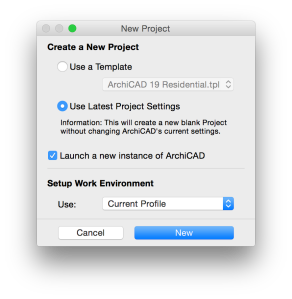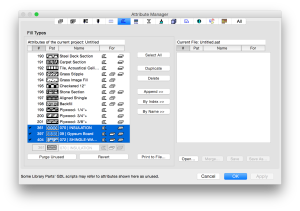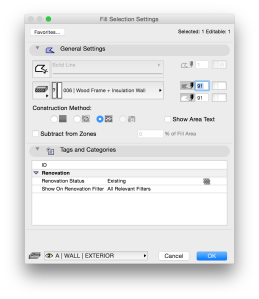You may recall the posts on keeping your library clean; here and here. But maintaining a clean, legible, and highly functional BIM file is more than just library management. It is also awareness of the attributes, and keeping those properly organized, sorted, named and vetted.
When creating an attribute it should be named and numbered appropriately for clear function, intent and organization. But attributes can become polluted, just like the libraries. This happens when bringing in downloaded objects which contain their own attributes or new attribute references, or when copying/pasting content from one ARCHICAD file into your working project.
Attributes are almost certainly going to come in in either case. So you can either bring the content in, then fix the libraries and attributes, or you can create a quick sandbox to preview and pre-clean the content.
To do this, simply select file > new, and set the resulting window use the latest project settings and launch in a new instance. This ensures the attributes and settings will match your current project for assessing the damage of copy/paste before traumatizing your project.
Once the content has been pasted or added to the sandbox file, review the embedded library for stray or polluted content, and the attribute manager for content that came in with the content.
In the attribute manager, look for any attributes (typically under lines, fills and surfaces) that have come in with the paste. These will typically show at the bottom of the list when sorting by attribute ID. Look for attributes with big gaps in ID sequence, or attributes underlined or italicized in the case of teamwork projects.
Once these attributes have been removed in the attribute manager, simply search for any content with missing attributes (find & select works wonders for this), and reassign attributes that will copy/paste into your working project file.
This is a little work up front, but will save tons of time on the back side trying to make sense of the project attributes and figuring out which attributes your project needs and which ones came in through sloppy copy/paste practices.



Cool solution. The other route is to create an empty template with as little as possible in it as ARCHICADly possible. Jeroen made a clean template for that purpose: http://www.masterscript.nl/epages/78066077.sf/en_GB/?ObjectPath=/Shops/78066077/Products/101 It’s on my to write about list for ages.
But I like your route because it shows how the garbage will interact with your file in addition to exposing the rouge attributes.
LikeLiked by 1 person
Advantage of a project sand box is you know what attributes you are supposed to work with, and naming/numbering matches
LikeLike
In the default OOTB Attributes (like Lines, Fills, BMats, etc) there are gaps in the Index Numbers, and in the list of Layer Attributes that we’ve used there are gaps, so junk Attributes that get copied in don’t always go to the bottom of the Index Number list in Attribute Manager. I plan on filling in all of the gaps in my AC19 template, but is there a different way to make sure that copied-in Elements’ Attributes alway Merge to the end of the Index Numbering instead of inserting themselves into empty Index Numbers? If you were using AttMgr to bring in Attributes you can either overwrite by Index (or Name now too, right?) or Merge to the end of the Index Numbering list, but you cannot insert into a gap in the Index Numbering from the Att Mgr. It seems counterintuitive that copying in Elements from another project would insert its Attributes and not always Merge them to the end.
LikeLiked by 1 person
Attributes will pollute if the original attribute number is not available. If you are pasting into a teamwork project, the new attributes appear underlined. It can be tricky to figure out what the new attributes are, which is why I like the sandbox solution. It gives s place to figure it out before you do anything to the project file. You could even sand box, turn everything to archicad late, solid line and empty fill before pasting. Then some quick rework after pasting to match attributes
LikeLike
Instead of removing them from the Attribute Manager, have you considered just grabbing a screenshot and going into the relevant (surface, fills, linetype) dialogs and deleting and replacing them? May be more foolproof?
LikeLiked by 1 person
That certainly saves a step, I think it really depends on what is actually brought in by the copy/paste and what it is going to be used for. Its pretty time consuming to go item by item deleting/replacing content if there is a lot of stuff to be removed. Also, the delete & replace only works if you have reserved all in a teamwork file, any unreserved sub-attributes or elements will show up with missing attributes.
LikeLike